Did you know that snow peas are not only delicious, but also incredibly nutritious? These vibrant green pods are packed with fiber, vitamins, and minerals, making them a fantastic choice for a healthy snack. Whether you enjoy them raw or cooked, snow peas offer a satisfying crunch and a burst of fresh flavor that will leave you craving more.
Join me as we explore the world of fresh snow peas, from selecting the best ones to storing them for maximum freshness. We’ll also dive into various ways to prepare and cook snow peas, so you can enjoy their crispness in a variety of dishes. Get ready to embark on a delicious journey filled with vibrant color and delightful flavors!
Key Takeaways:
- Snow peas are a nutritious and versatile vegetable that can be eaten raw or cooked.
- They are rich in fiber, vitamins, and minerals, making them a healthy snack option.
- When selecting snow peas, look for vibrant green pods that are firm and crisp.
- Proper storage and preparation techniques will help maintain the freshness and crunch of snow peas.
- Snow peas can be enjoyed in salads, stir-fries, sautés, and other delicious recipes.
The Delicate and Versatile Snow Peas
Snow peas are a tender and sweet vegetable that is popular in various cuisines, particularly in Asian dishes. Unlike traditional English peas, snow peas have edible pods that are thin and tender. They are low in fat but rich in fiber, carbohydrates, protein, calcium, and vitamins. Snow peas are widely available in mid-late spring, early summer, and mid-fall.
These delicate and versatile vegetables offer a refreshing crunch and vibrant color to dishes, making them a favorite among chefs and home cooks alike. Whether enjoyed raw in salads or cooked in stir-fries, snow peas are a fantastic way to add flavor and texture to your meals.
“Snow peas are like nature’s green envelopes, holding a delightful surprise inside. Their mild sweetness and crispness bring a beautiful balance of flavors to any dish.” – Chef Sarah Chen
Let’s explore some of the ways you can incorporate snow peas into your culinary creations:
- Snow Pea Stir-Fry: Sauté snow peas with garlic, ginger, and your choice of protein for a quick and healthy stir-fry. The tender pods add a refreshing contrast to the dish.
- Snow Pea Salad: Toss blanched snow peas with mixed greens, cherry tomatoes, and a tangy dressing for a light and vibrant salad.
- Snow Pea Soup: Purée blanched snow peas with vegetable broth, mint, and lemon juice for a refreshing and nutritious soup.
- Snow Pea Noodle Bowl: Create a hearty bowl of noodles with snow peas, tofu, carrots, and a flavorful sauce. The snow peas add a satisfying crunch to every bite.
No matter how you choose to prepare them, snow peas are sure to elevate your dishes with their delicate flavor and versatility.
Now, take a moment to appreciate the beauty of snow peas in their raw form:
How to Select Fresh Snow Peas
When purchasing snow peas, look for:
| Quality Criteria | Description |
|---|---|
| Color | Vibrant green pods that are free from discoloration or blemishes. |
| Texture | Firm, crisp pods that snap when bent. |
| Shape | Straight, flat pods without any signs of wilting or sagging. |
By following these guidelines, you can ensure that you’re selecting the freshest snow peas for your culinary adventures.
Selecting and Storing Snow Peas
When it comes to selecting the best snow peas for your meals, there are a few key things to keep in mind. Look for smooth and unblemished pods that are wide, flat, and somewhat flexible. These are signs of freshness and quality. Avoid pods that appear limp or soft, as they may be past their prime.
For a visual reference, refer to the table below, which summarizes the key characteristics of quality snow peas:
| Characteristics of Fresh Snow Peas |
|---|
| Vibrant green color |
| Firm and crisp texture |
| Smooth and unblemished pods |
| Wide, flat shape |
| Some flexibility |
Once you have selected your snow peas, it’s important to store them properly to maintain their freshness. Snow peas should be kept in a closed container or a plastic bag in the refrigerator. This helps to prevent moisture loss and maintain their crispness. Stored this way, snow peas can stay fresh for 7-10 days.
To demonstrate the ideal storage method, here’s an image of snow peas stored in the refrigerator:
However, if you find that you won’t be able to consume your snow peas within that timeframe, don’t worry! They can still be enjoyed at a later date. Consider blanching the snow peas and freezing them. Blanching involves quickly boiling the snow peas for a short period and then transferring them to an ice bath to stop the cooking process.
By blanching and freezing your snow peas, you can extend their shelf life and have them readily available for future use. Whether you choose to store them in the refrigerator or freeze them, it’s important to enjoy snow peas at their freshest to savor their delicate flavor and crisp texture.
Preparing Snow Peas for Snacking and Salads
Snow peas are not only great for snacking on their own, but they also make a delicious addition to salads. To make the most of these crisp and flavorful peas, you’ll need to prepare them properly.
To get started, you’ll want to trim the stem end of each snow pea. This can be easily done by using a small knife to remove the tough portion.
Once you’ve trimmed the snow peas, you’ll want to remove the tough string that runs along the edge of each pod. This string is known as the “string” or “vein” and can be tough and fibrous. To remove it, simply hold the snow pea firmly with one hand and use your other hand or a small knife to pull or cut the string away.
By preparing your snow peas in this way, you’ll be left with tender and delicious pods that are perfect for snacking or incorporating into a salad.
Pro tip: If you’re short on time, you can find pre-trimmed snow peas at the grocery store or opt for sugar snap peas, which don’t require any trimming.
Quick and Easy Ways to Cook Snow Peas
When it comes to cooking snow peas, you have several quick and easy methods at your disposal. These versatile vegetables, known for their natural sweetness, can be prepared in various ways to bring out their vibrant flavor and crisp texture. Whether you prefer sautéing, stir-frying, steaming, or blanching, there’s a cooking method that will suit your taste and culinary style.
Sautéing Snow Peas with Garlic and Oil
Sautéing snow peas in a hot skillet with garlic and oil is a simple yet delicious way to bring out their natural sweetness. The combination of fragrant garlic and savory oil adds depth to the flavor profile of the snow peas. Here’s a step-by-step guide to sautéing snow peas:
- Heat oil in a skillet over medium-high heat.
- Add minced garlic and cook for about 30 seconds until fragrant.
- Add the snow peas to the skillet and sauté for 2-3 minutes until they turn bright green.
- Season with salt and pepper to taste.
Once sautéed, the snow peas can be served as a standalone side dish or incorporated into salads and stir-fries for added flavor and crunch.
Stir-Frying Snow Peas with Other Ingredients
Stir-frying is a popular cooking technique in Asian cuisine that results in quick-cooked, vibrant dishes. By stir-frying snow peas alongside other ingredients, you can create a flavorful and colorful stir-fry. Here’s how you can make a delicious snow pea stir-fry:
- Heat oil in a wok or large skillet over high heat.
- Add your choice of protein (such as chicken, beef, shrimp, or tofu) and cook until almost cooked through.
- Add chopped vegetables like bell peppers, carrots, and onions.
- Toss in the snow peas and stir-fry for a few minutes until all the ingredients are cooked to your desired tenderness.
- Season with soy sauce, ginger, and garlic for an authentic Asian flavor.
This snow pea stir-fry can be served over rice or noodles for a satisfying and complete meal.
Steaming and Blanching Snow Peas
If you prefer to retain the natural sweetness and crispness of snow peas, steaming or blanching is the way to go. These methods preserve the vibrant green color and delicate texture of the peas. Here’s how to steam or blanch snow peas:
- To steam, fill a steamer pot or a saucepan with about 1 inch of water and bring it to a boil.
- Place the snow peas in a steamer basket or a sieve and steam for 2-3 minutes until they turn bright green and are tender-crisp.
- Remove the snow peas from the heat and serve as a refreshing side dish or add them to noodle bowls for an added burst of flavor and nutrition.
- If you prefer blanching, bring a pot of water to a rolling boil.
- Add the snow peas and blanch them for 30-60 seconds, then transfer them to an ice bath to stop the cooking process.
- Drain the snow peas and use them in salads or freeze them for later use.
Steamed or blanched snow peas are excellent options for salads, as they retain their crispness and pop of sweetness.
Sauteed Snow Peas Recipe
Looking for a simple and flavorful way to enjoy snow peas? Try this sautéed snow peas recipe for a delicious side dish or a flavorful garnish. The sautéing process brings out the natural sweetness of the snow peas while preserving their bright green color and crisp texture.
- 1 pound of snow peas, washed and trimmed
- 2 tablespoons of oil (such as olive or vegetable oil)
- 2 cloves of garlic, minced
- Salt and pepper to taste
- Optional: sesame seeds for garnish
Instructions:
- Heat the oil in a skillet over medium-high heat.
- Add the minced garlic to the skillet and sauté until fragrant, about 1 minute.
- Add the snow peas to the skillet and sauté for 2-3 minutes, stirring occasionally, until they turn bright green and slightly tender.
- Season the snow peas with salt and pepper to taste.
- Optional: Sprinkle sesame seeds over the sautéed snow peas for added flavor and visual appeal.
- Remove the skillet from heat.
- Serve the sautéed snow peas as a delicious side dish or use them as a flavorful garnish for your favorite dishes.
Enjoy the sautéed snow peas while they’re still warm for maximum flavor and crunch. They pair well with a variety of main dishes, such as grilled chicken, seared salmon, or tofu stir fry. You can also incorporate them into salads or add them to noodle bowls for an extra burst of freshness.
Get creative and try experimenting with different seasonings or adding other vegetables to customize the recipe to your taste. The possibilities are endless when it comes to enjoying sautéed snow peas!
Steamed Snow Peas Recipe
If you’re looking for a simple and nutritious side dish or a flavorful addition to noodle bowls, this steamed snow peas recipe is perfect. Steaming snow peas helps retain their vibrant green color and preserves their crispness. Follow these easy steps to create tender and delicious steamed snow peas:
- Fill a steamer pot with about 1 inch of water and bring it to a boil.
- Meanwhile, prepare the snow peas by washing them thoroughly and removing the string that runs along the edge of each pod.
- Place the prepared snow peas in a steamer basket or a heatproof bowl.
- Once the water in the pot is boiling, carefully place the steamer basket or bowl with the snow peas inside.
- Cover the pot with a lid and steam the snow peas for 2-3 minutes until they become bright green and slightly tender.
- Remove the snow peas from the heat and transfer them to a serving dish.
- If desired, you can sprinkle them with a pinch of salt or drizzle them with a light dressing for added flavor.
- Serve the steamed snow peas as a refreshing side dish or incorporate them into your favorite noodle bowls for an extra burst of texture and nutrition.
Steamed snow peas make a versatile addition to a variety of dishes and can be enjoyed on their own or paired with other ingredients. Their natural sweetness and delicate crunch enhance the overall taste and presentation of your meals.
“Steaming snow peas helps retain their vibrant green color and preserves their crispness.”
Here’s a quick summary of the steamed snow peas recipe:
| Ingredients: | Instructions: |
|---|---|
| Snow peas | 1. Fill a steamer pot with about 1 inch of water and bring it to a boil. 2. Prepare the snow peas by washing them and removing the string. 3. Place the snow peas in a steamer basket or heatproof bowl. 4. Steam for 2-3 minutes until bright green and slightly tender. 5. Remove from heat and transfer to a serving dish. Serve as desired. |
Enjoy the simplicity and freshness of steamed snow peas with this easy recipe. Add them to your culinary repertoire for a healthy and flavorful addition to your meals.
Blanching Snow Peas for Salads and Freezing
Blanching snow peas is a simple yet effective technique to enhance their sweetness, preserve their vibrant color, and remove any fibrousness. Whether you want to use them in salads or store them for later use, blanching is the perfect method. Here’s how to blanch snow peas to perfection:
- Start by bringing a pot of water to a rolling boil.
- While the water is heating, prepare an ice bath by filling a large bowl with cold water and ice cubes.
- Once the water reaches a boil, carefully drop the snow peas into the pot.
- Blanch the snow peas for 30-60 seconds. This short cooking time will help maintain their crispness.
- Using a slotted spoon or tongs, transfer the blanched snow peas immediately to the ice bath. This rapid cooling process, known as “shocking,” stops the cooking process and helps preserve their vibrant color.
- Let the snow peas sit in the ice bath for a couple of minutes until completely cooled.
- Remove the snow peas from the ice bath and drain them well.
Now that your snow peas are blanched, you can use them in a variety of ways. They make a tasty addition to salads, providing a delightful crunch and vibrant green color. Alternatively, if you have an abundance of snow peas, you can freeze them for later use.
Here’s a simple snow pea salad recipe to showcase the blanched snow peas:
Refreshing Snow Pea Salad
This vibrant salad combines blanched snow peas with a tangy vinaigrette and crisp vegetables for a refreshing springtime dish.
- Blanched snow peas
- Cucumbers, thinly sliced
- Radishes, thinly sliced
- Cherry tomatoes, halved
- Red onion, thinly sliced
- Feta cheese, crumbled
- Fresh herbs (such as mint, basil, or parsley), chopped
Toss the blanched snow peas and the remaining ingredients together in a large bowl. Drizzle with your favorite vinaigrette and season with salt and pepper to taste. Serve chilled and enjoy!
Blanching snow peas not only enhances their flavor and texture but also allows you to extend their shelf life by freezing them. Simply pack the blanched snow peas into airtight containers or freezer bags and store in the freezer for up to 6 months. They can be added directly to stir-fries or other cooked dishes without the need to thaw.
Blanching snow peas is an excellent way to unlock their full potential in salads and ensure you always have a stash of this delightful vegetable in your freezer for quick and convenient meals. Try blanching snow peas today and experience the difference it makes in your culinary creations!
Creative Ways to Use Snow Peas in Cooking
Snow peas are not only versatile but also add a delightful crunch and vibrant color to a wide range of dishes. Whether you’re a beginner or a seasoned cook, incorporating snow peas into your recipes can elevate the taste and presentation of your meals. Here are some creative ways to use snow peas in your cooking adventures:
- In Curries: Snow peas can bring a fresh and crisp element to rich and flavorful curries. Add them towards the end of the cooking process to retain their crunchy texture.
- In Stir-Fries: Stir-frying snow peas with other vegetables and protein options such as beef, pork, seafood, or tofu creates a delicious and healthy meal. The combination of colorful ingredients and the sweet crunch of snow peas is hard to resist.
- In Salads: Upgrade your salads by tossing in fresh snow peas. Their vibrant green color and satisfying crunch make them an excellent addition to both leafy green salads and grain-based salads. Try pairing them with cherry tomatoes, cucumber, and a tangy vinaigrette for a refreshing bite.
- In Soups: Snow peas can add texture and visual appeal to soups. Add them to vegetable or chicken-based soups during the last few minutes of cooking to preserve their vibrant color and crunch.
- Stuff with Cream Cheese: For a unique and crowd-pleasing appetizer, stuff blanched snow peas with creamy, flavored cream cheese. They make for an elegant finger food at parties or a delightful addition to a picnic basket.
- In Pasta Dishes: Snow peas can bring freshness and crunch to pasta dishes. Toss blanched snow peas with cooked pasta, olive oil, garlic, grated cheese, and a squeeze of lemon juice for a simple and satisfying meal.
As you experiment with snow peas in your cooking, feel free to explore your creativity and mix them with your favorite ingredients. The possibilities are endless!
Table: Cooking Ideas Using Snow Peas
| Dish | Ingredients | Instructions |
|---|---|---|
| Snow Pea Stir-Fry | Snow peas, beef, garlic, soy sauce, sesame oil | 1. Heat oil in a skillet. 2. Add beef and garlic, cook until browned. 3. Add snow peas, soy sauce, and sesame oil. 4. Stir-fry for a few minutes until snow peas are tender-crisp. 5. Serve hot over rice. |
| Snow Pea Salad | Snow peas, cherry tomatoes, cucumber, red onion, feta cheese, balsamic vinaigrette | 1. Blanch snow peas in boiling water, then cool in ice water. 2. Combine snow peas, cherry tomatoes, cucumber, red onion, and feta cheese in a bowl. 3. Drizzle with balsamic vinaigrette. 4. Toss gently to combine. 5. Serve chilled. |
| Snow Pea Curry | Snow peas, curry paste, coconut milk, tofu, bell peppers, basil leaves | 1. Heat oil in a pan, add curry paste, and cook until fragrant. 2. Add coconut milk and bring to a simmer. 3. Add tofu, bell peppers, and snow peas. 4. Cook until the vegetables are tender. 5. Stir in basil leaves just before serving. 6. Serve hot with rice or noodles. |
The Joy of Eating Snow Peas Raw
Snow peas are a delightful treat when enjoyed raw. Their crisp texture and subtle sweetness make them a perfect snack or addition to salads. Here’s a simple guide to savoring the freshness of raw snow peas:
- Trim and remove the string: Start by trimming the stem end of the snow pea and then gently remove the tough string that runs along the edge of each pod. This step ensures that you are left with tender and edible pods that are ready to be enjoyed.
- Snack on their own: Once prepared, raw snow peas are delicious when eaten on their own. Take a bite and revel in the satisfying crunch and natural flavor of these vibrant green pods.
- Dip in hummus: For an extra burst of flavor, try dipping raw snow peas in creamy hummus. The combination of the crunchy pea pods and creamy hummus creates a delightful contrast of textures and flavors.
- Use as a salad topping: Add a refreshing twist to your salads by incorporating raw snow peas. Slice them diagonally for an appealing presentation and sprinkle them on top of your leafy greens. Their vibrant color and refreshing crunch will elevate your salad to new heights.
So next time you grab a handful of fresh snow peas, consider enjoying them raw for a refreshing and healthy snack. They are not only packed with nutrients but also provide a burst of natural sweetness that is sure to satisfy.
The Freshness Factor: Selecting the Best Snow Peas
When it comes to selecting snow peas, freshness and quality should be your top priorities. Choosing the right snow peas will ensure that you enjoy the best flavor and texture in your dishes. Here are a few tips to help you select the freshest and highest quality snow peas:
Look for Vibrant Green Pods
When you’re at the grocery store or market, keep an eye out for snow peas with vibrant green pods. The color of the pods is a good indicator of their freshness. Fresh snow peas will have a bright and vibrant green color, indicating that they are still at their peak.
Firm and Crisp Pods
Gently squeeze the pods of the snow peas to check for firmness. Freshly picked snow peas will feel firm and crisp in your hand. Avoid snow peas that feel soft or have a wrinkled texture, as this might be a sign of age or deterioration.
Avoid Wilted, Discolored or Damaged Snow Peas
Inspect the snow peas thoroughly and avoid any that appear wilted, discolored, or damaged. Wilted or discolored snow peas are likely past their prime and will not have the best flavor or texture. Look for snow peas that are free from any bruises, spots, or mold.
Listen for the Snap
One trick to determine the freshness of snow peas is to snap one of the pods. Fresh snow peas will produce a satisfying snap when broken in half. This indicates that the peas are crisp and packed with flavor. On the other hand, if the pod bends without snapping, it is a sign that the snow peas are no longer fresh.
Choose Locally Sourced Snow Peas
To ensure the highest quality and freshness, consider choosing locally sourced snow peas. Locally grown snow peas are more likely to be harvested at their peak and will have a shorter travel time to the market, resulting in maximum freshness and flavor.
By following these tips, you can confidently select the best snow peas for your cooking needs. Incorporating fresh and quality snow peas into your recipes will enhance the taste and overall experience of your dishes.
Snow Pea Selection Checklist
| Criteria | What to Look For |
|---|---|
| Color | Vibrant green pods indicate freshness. |
| Texture | Firm and crisp pods are a sign of high quality. |
| Appearance | Avoid wilted, discolored, or damaged snow peas. |
| Sound | A satisfying snap when breaking a pod indicates freshness. |
| Source | Choose locally sourced snow peas for peak flavor. |
Conclusion
Snow peas are a delightful addition to any kitchen, bringing freshness, crispness, and vibrant color to a wide range of dishes. Whether enjoyed raw or cooked, these versatile and nutritious vegetables offer a unique flavor and delightful texture that can elevate any recipe.
For a truly satisfying snow pea experience, it’s crucial to start with the freshest produce available. When selecting snow peas, look for vibrant green pods that are firm and crisp. The snapping sound when you break a pod is a good indicator of freshness.
To make the most of snow peas in your cooking, it’s important to properly clean and trim them. Remove the tough strings that run along the edges of each pod to ensure a tender and enjoyable eating experience. Once prepared, you can explore various cooking methods such as sautéing, steaming, stir-frying, or blanching to unlock their full potential.
The possibilities are endless when it comes to cooking with snow peas. They can be the star of refreshing salads, add a delightful crunch to stir-fries, or be the perfect accompaniment to meats, seafood, and other vegetables. Whichever recipe you choose, snow peas will bring a burst of flavor and visual appeal to your meals.

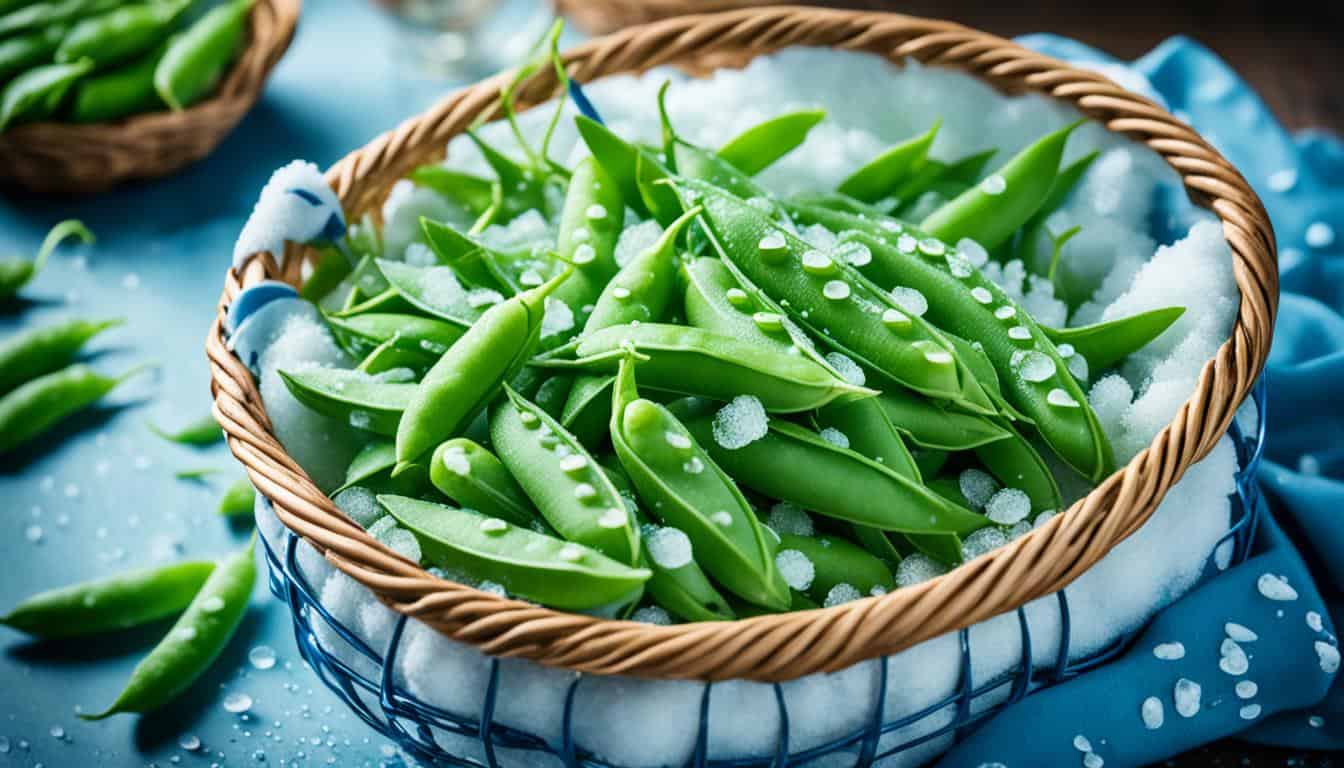
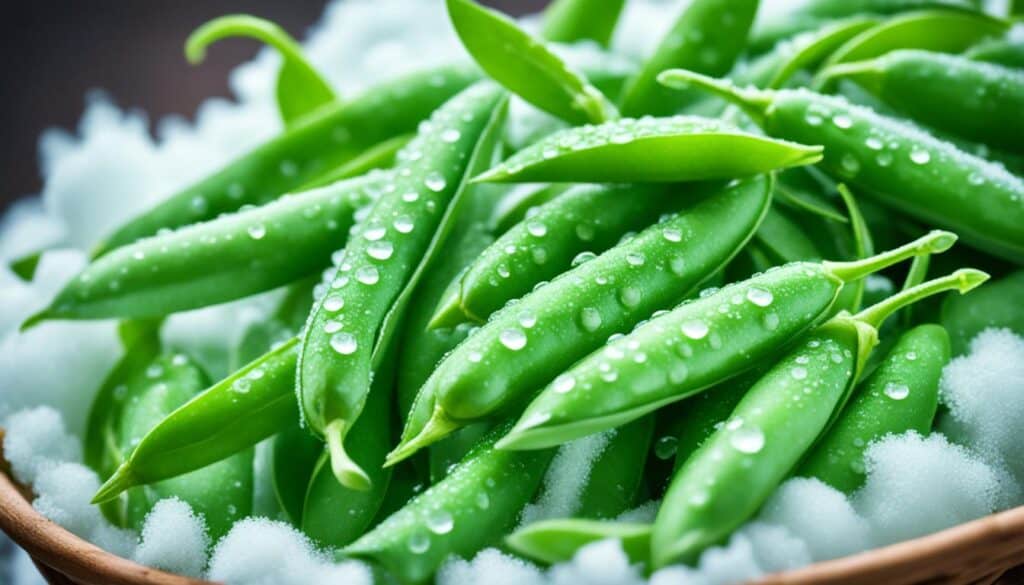
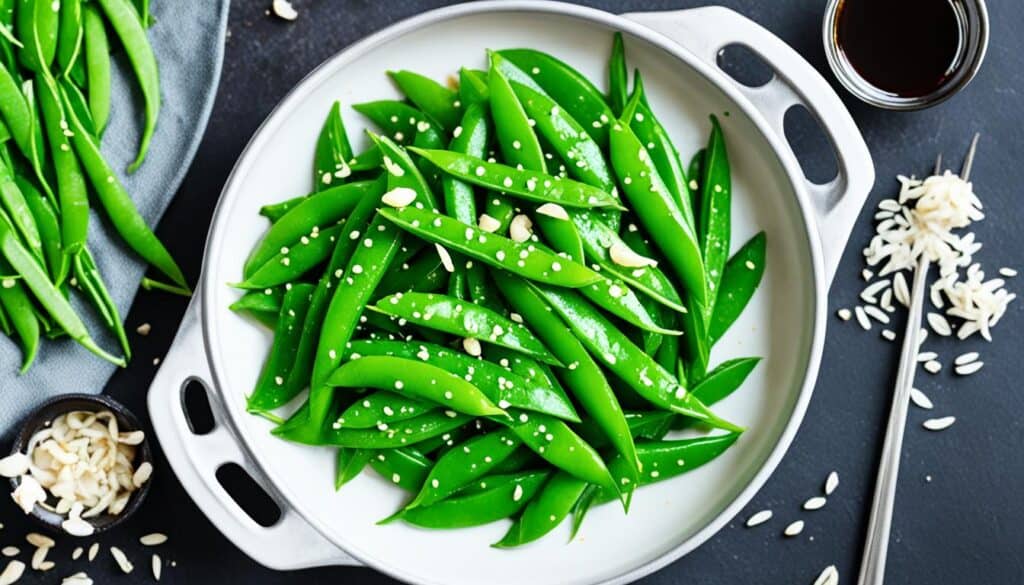
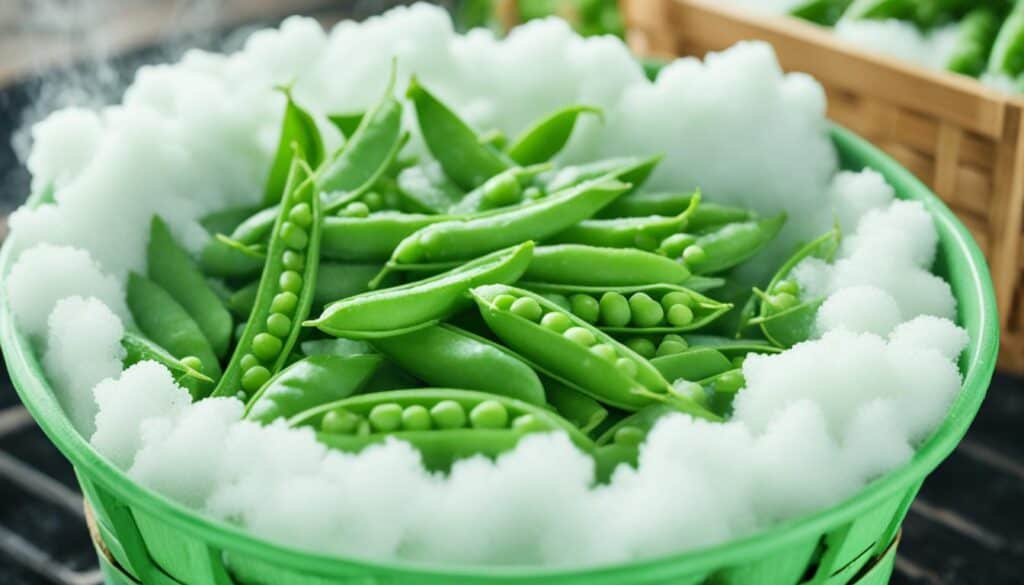
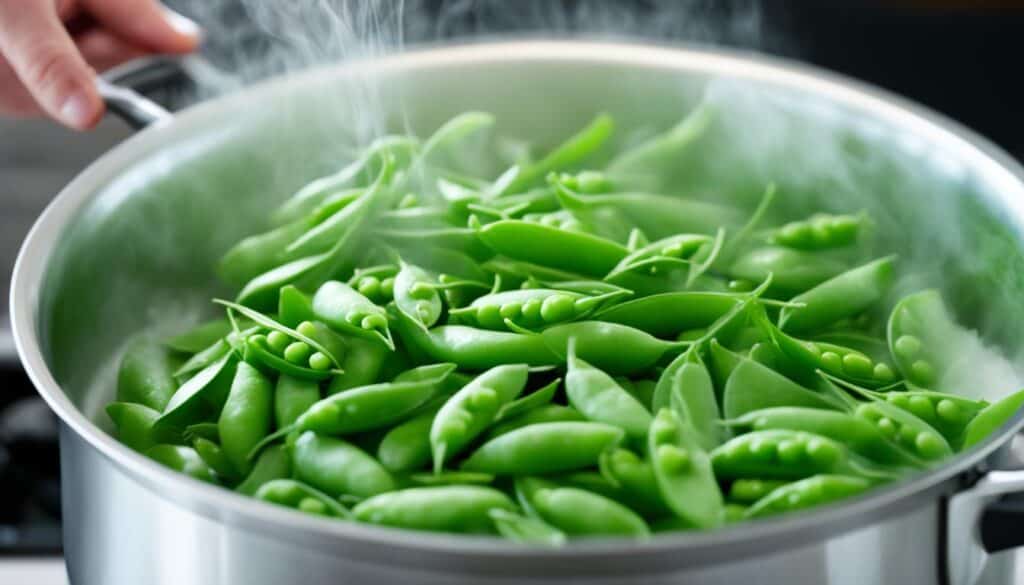
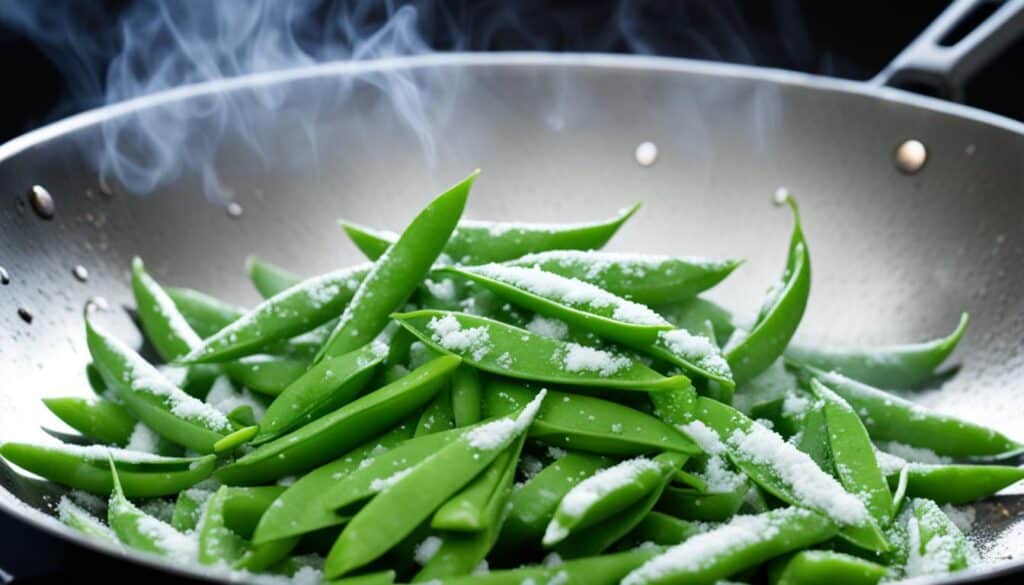



Leave a Reply